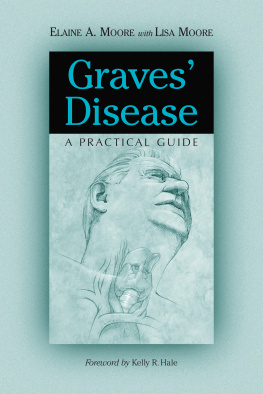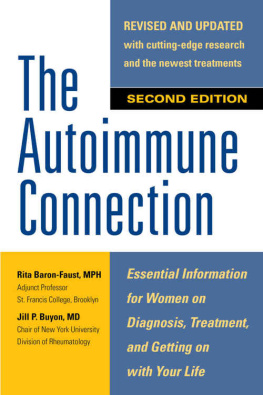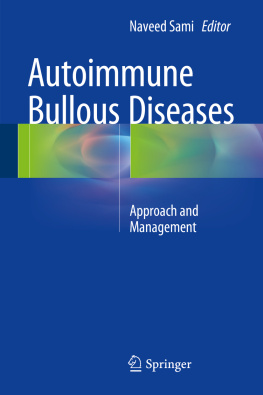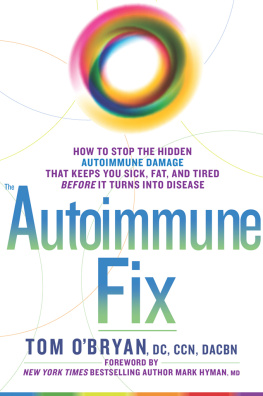
Table of Contents
Also by Elaine A. Moore with Lisa Moore
Graves Disease: A Practical Guide
(McFarland, 2001)
This book is intended as an educational resource and not as a substitute for medical treatment. Patients with autoimmune disease need to be under the care of a qualified physician or an alternative medicine provider. It is important for all patients to consult with their medical advisors before making any changes in their therapeutic regimen.
Library of Congress Cataloguing-in-Publication Data
Moore, Elaine A., 1948
Autoimmune diseases and their environmental triggers / by Elaine A. Moore.
p. cm.
Includes bibliographical references and index.
ISBN 0-7864-1322-0
1. Autoimmune diseasesPopular works. 2. Environmentally induced diseasesPopular works. [DNLM:
1. Autoimmune Diseasesetiology. 2. Autoimmune Diseasestherapy. 3. Complementary Therapies. 4. Environmental Pollutantsadverse effects.
WD 305 M821a 2002] I. Title.
RC600 .M665 2002
616.97'8dc21 2002003869
British Library cataloguing data are available
2002 Elaine A. Moore. All rights reserved
No part of this book may be reproduced or transmitted in any form or by any means, electronic or mechanical, including photocopying or recording, or by any information storage and retrieval system, without permission in writing from the publisher.
Cover illustrations by Marvin G. Miller
McFarland & Company, Inc., Publishers
Box 611, Jefferson, North Carolina 28640
www.mcfarlandpub.com
To Rick
Acknowledgments
Id like to take this opportunity to thank my husband Rick and my children, Brett and Lisa, for their constant encouragement and support. I also owe special thanks to my many friends and relatives who have autoimmune disease, especially Jody, Drew, Julie, Sally and Maria. Their questions inspired me to explore the origins of the many disorders that target the bodys own tissues and cells. The basic question posed to me, often stated as why me? sparked my interest and helped frame the chapters of this book.
Many thanks also goes to Deb Howe and the board members of Howe Charities in Lexington, Kentucky, for awarding me an environmental writing grant. Their enthusiasm for this project encouraged me more than they can imagine. And special thanks to Virginia Ladd, President of the American Autoimmune Related Diseases Association (AARDA), for the wealth of information she graciously shared.
Id also like to express my gratitude to the U.S. National Institutes of Health for allowing me to share the findings presented at the 1998 conference, Linking Environmental Agents to Autoimmune Disease, jointly sponsored by the Juvenile Diabetes Foundation International, the U.S. Environmental Protection Agency and AARDA. And thanks to the many scientists who brought these findings to light.
Lastly, Id like to thank my friend and co-worker, Marvin G. Miller, for his clever illustrations, which once again have helped make a complex subject easy to understand.
List of Illustrations
Basic Human Cell
Antibody Titres
Antigen-Antibody Reaction and Immunoglobulin Structure
Immunoglobulin Classes
The Mind-Body Connection
Immune System Organs
Primary Lymphoid Tissue
Peripheral Blood Components
Granulocytic Cell Development
Lymphocyte Development
Central Role of the Helper T Cell in the Immune Response
T Cell Response to Viral Antigen Leading to Autoantibody Production
Cytotoxic T Cell Attacking Infected Cell or Cancer Cell
The Immune Response
Antigens and Antibodies
Antigen Presenting T Cell
MHC-Antigen Complex Interacting with Helper T Cell
Kidney Structure
Immune Complexes in Autoimmune Kidney Disease
Autoimmune Effects on Synovium in Rheumatoid Arthritis
Introduction
Most people realize that a high cholesterol level and sedentary lifestyle are risk factors for heart disease. But how many people can recite the risk factors for autoimmune disease (AD)? Then again, how many people know what ADs are?
The generic term autoimmune disease refers to a number of different disorders that originate in the immune system. The underlying cause of these disorders is an immune system defect that goads the immune system into deviating from its normal protective functions. Led astray by environmental and genetic influences, the immune system spurs an attack against the bodys own tissues and cells.
Simply stated, according to current theory, ADs develop in individuals with a certain combination of genes and lifestyle factors who are exposed to certain environmental triggers. These environmental triggers include hormones, stress, infectious agents, vaccines, heavy metals such as mercury and lead, traumatic injury, ultraviolet radiation and a plethora of industrial, medicinal and agricultural chemicals.
A National Institutes of Health publication, Understanding Autoimmune Diseases, advises that physicians warn their autoimmune disease patients about environmental triggers. Avoiding these triggers, this bulletin reports, could prevent symptoms from flaring up or progressing. Unfortunately, however, few patients ever hear this warning.
The Role of Environmental Triggers
Patients hearing this warning might wonder how environmental agents can affect the arthralgia (joint pain and stiffness), fatigue, neurological symptoms and muscle pain that rule their lives. After all, ADs seem to have inexplicable lives of their own, with symptoms that mysteriously change over time. Periods of remission alternate with periods of variable symptom severity. In some instances, even the predominant symptoms change over time, with blistering rashes miraculously vanishing only to be replaced by crippling joint pain.
For many years, patients and their doctors saw no logic to this waxing and waning of symptoms. Now scientists know that a variety of environmental factors influence the immune response, thereby affecting both the symptoms and the disease course. However, in the early stages of autoimmune disease, symptoms are often insidious. Thus, when symptoms are easiest to treat and the avoidance of environmental triggers most likely to elicit remissions, patients arent often sure if they even need to see a doctor.
Diagnostic Difficulties
Even when doctors are consulted, early, vague AD symptoms are likely to be ignored. A survey conducted by the American Autoimmune Related Diseases Association (AARDA) reported that the medical complaints of women, the prime targets of AD, are often dismissed. Many survey respondents stated that, before their diagnoses, they were regarded as hypochondriacs. A number of these women report being treated for anxiety and given antidepressant drugs. A related AARDA publication reports that for ADs, an accurate diagnosis takes an average of seven years and five doctors.
The list of ADs is long and includes diseases as common as insulin dependent diabetes mellitus, myasthenia gravis and rheumatoid arthritis. The connective tissue diseases, in particular, often stymie even the most astute diagnosticians. The rheumatologic autoimmune disorder Sjgrens syndrome (SS) is particularly difficult to diagnose because many of its symptoms mimic symptoms seen in other diseases including systemic lupus erythematosus (SLE) and rheumatoid arthritis (RA). Does it really matter if a patient has SLE or RA alone, RA or SLE with SS, or SS alone?
Definitely. Some medications used for treatment of SLE or RA or even the common cold can exacerbate or worsen symptoms in Sjgrens syndrome. And whether SS occurs alone or accompanies another AD, coexisting as a secondary disorder, has much to say about a particular diseases progression and severity.
Next page












